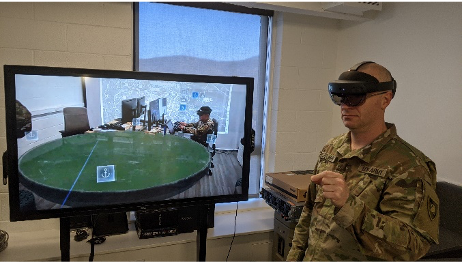ARLINGTON, Va. — At the Army Cyber Institute at the U.S. Military Academy, researchers are looking at how virtual reality and augmented reality may change the way soldiers train and fight.
Collectively known as extended reality, or XR, these tools offer a new take on situational awareness. “Now you’re no longer having to look at a map. You can immerse yourself in a virtual or augmented world, and you’ll be able to learn things just by looking,” said Lt. Col. Todd Arnold, a cyber officer and research scientist with the Army Cyber Institute at West Point.
A pair of research projects help to show what that XR-informed world might look like.
In one project, researchers are exploring ways to show soldiers at a glance the whereabouts of electromagnetic sources.
“You look to the right side and see: There’s a [Wi-Fi] access point in use, or there’s a radio, or there’s a cell phone,” said assistant professor Col. Stephen Hamilton. “If you see a whole bunch of stuff going on, and you know what kind of devices are in there, you can get a better picture of what’s happening before walking into that building.”
That information would be displayed on a headset, with the soldier able to see the electronic activity overlayed on top of the actual physical scene. The team is experimenting with Microsoft HoloLens smart glasses as a potential delivery device.
In a second project, the institute is developing a virtual sand table.
“It comes from the idea of taking a stick and drawing the battle plan in the sand,” Arnold said. “I can tell you I want you to go down this road and do this, but in a virtual reality environment I can actually show you. I want you to kick in thatdoor. Nope, not the first door on the left, the second door on the left. And you can actually practice that in virtual reality before going in.”
As a training tool, a virtual sand table would have a number of potential advantages. For one thing, the researchers note, geographically disconnected troops could train together on the same model, in real time. That would help to ensure a certain continuity of experience and expectation.
In addition, an XR training experience could bring a higher level of realism to the training exercise.
“Suppose you’re going to have some plan of attack,” Hamilton said. “Depending on how detailed the model is, you can actually put yourself there and walk through it. You can have the soldiers actually practice the scenario inside that building, in that virtual space.”
The road forward
Right now, the researchers said, real-world implementation is five to 10 years away. A number of factors will need to come together to make virtual training a commonplace Army experience.
Hamilton pointed to issues with the hardware, as an example. Commercial headsets don’t yet offer a wide-enough field of view, an effect he described as “looking down a hose.”
Army investment in an Integrated Visual Augmentation System (IVAS) could help move the needle on that issue. That program aims to integrate key XR technology systems into one device to provide a single platform for soldiers to fight, rehearse and train.
“They’ve got the funding to do that, and it will be a big step forward,” Hamilton said. “They’re working on getting something that’s hardened and ruggedized and that a soldier can actually use.”
Another Army Cyber Institute researcher, Jan Kallberg, points to mechanical and cultural hurdles that still need to be overcome before XR can go mainstream.
On the mechanical side, systems need to be made more robust. “Systems like this work perfectly in a national training center where they may be tested for 12 hours or 18 hours,” he said. “But a great power conflict is not going to be a 12-hour event. It can be a drawn-out conflict. We will need to consider things like battery life and wear-and-tear.”
On the cultural side, the Army will have to win buy-in from soldiers who will be asked to entrust their safety to virtual renditions.
“As humans, we trust our own senses first,” Kallberg said. “You need for them to trust the pixel: They will need to believe in the data integrity. There will be a trust issue that has to be addressed.”
If these hurdles can be overcome, though, the researchers say there is much to be gained by an XR approach.
“It’s not easy to share situational awareness,” Arnold said. “This has the ability to share information so much faster than what you could possibly have, if you were getting it any other way.”








